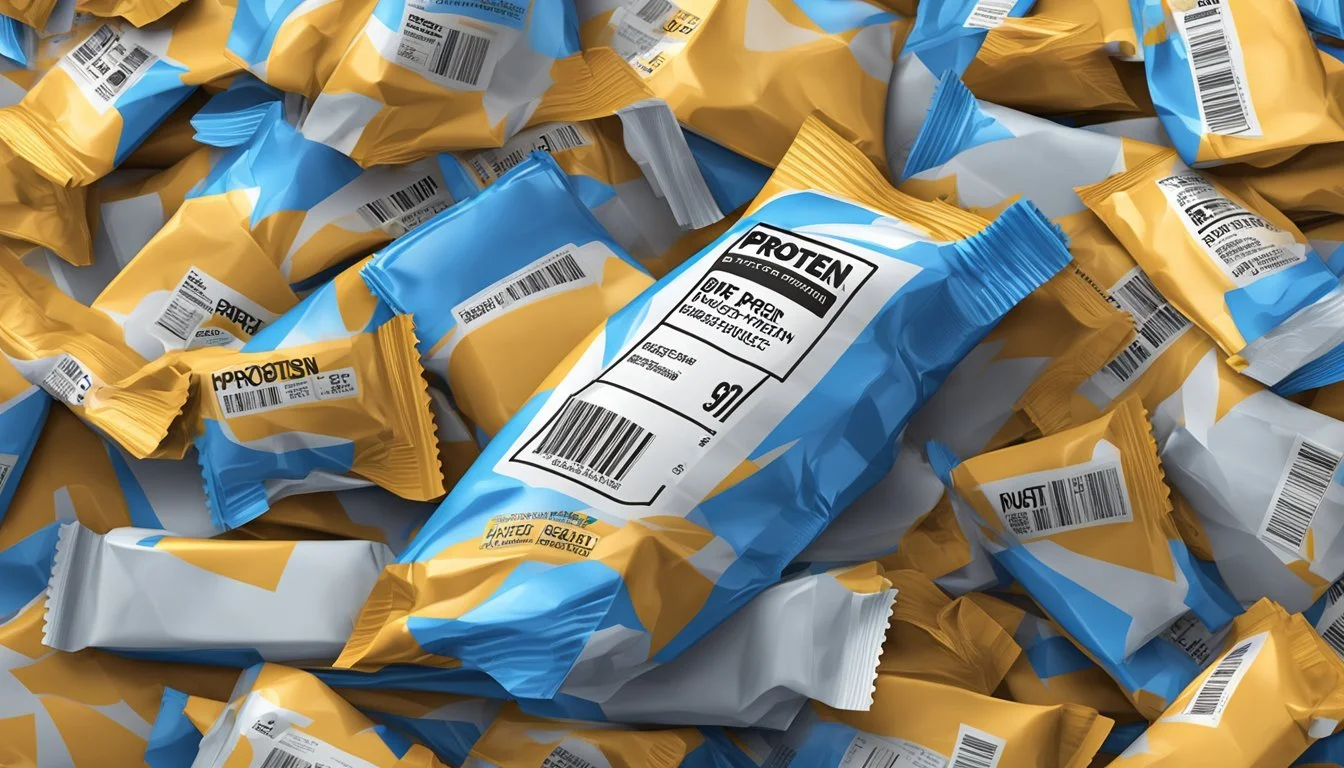How Many Servings of Pure Protein Bars Is Too Much
Understanding Safe Consumption Levels
When it comes to meeting daily protein needs, protein bars can be a convenient option. But there's a fine line between beneficial and too much. Generally, consuming one or two protein bars per day is recommended to avoid excessive intake of calories, sugars, and fats.
Each bar typically offers 150-350 calories and a variety of nutrients that can significantly impact your diet. Reading nutrition labels helps ensure you're not inadvertently consuming more than necessary.
Overindulgence in protein bars can lead to unwanted side effects such as stomach discomfort, irritability, and dehydration. Balance is key to enjoying the benefits without harming your health.
Understanding Protein Bars
Protein bars serve as a convenient snack or meal replacement option, packed with essential nutrients like protein, carbohydrates, fats, and fiber. This section will cover the nutritional profile and common ingredients found in protein bars.
Protein Bar Nutrition Profile
Protein bars typically range from 150 to 350 calories per bar, making them versatile for various dietary needs. A standard protein bar often includes 15 to 21 grams of protein, which supports muscle repair and growth. The calorie content primarily comes from protein, carbohydrates, and fats.
The carbohydrate content in protein bars varies widely. Some bars are low-carb, featuring around 17 to 21 grams of carbohydrates, while others may contain more, depending on their intended use (e.g., energy bars). These carbs can offer dietary fiber benefits, often comprising 3 to 10 grams of fiber per bar to aid digestion and satiety.
Fat content is another critical component, generally ranging from 5 to 10 grams per bar. This includes healthy fats derived from nuts and seeds, which provide additional nutritional benefits. Monitoring sugar content is crucial; many protein bars have 10 grams or less of added sugar, while others might use sugar alcohols to reduce caloric impact without compromising sweetness.
Common Ingredients in Protein Bars
Protein bars feature a variety of ingredients tailored to meet specific dietary goals. Common protein sources include whey, soy, and pea protein. These proteins offer a complete amino acid profile, making them highly effective for muscle repair and growth.
Carbohydrates in protein bars often come from oats, rice crisps, or sweeteners such as honey and agave syrup. These ingredients provide energy and enhance flavor while contributing to the carbohydrate count.
Fat sources are typically nuts and seeds, such as almonds and chia seeds, which offer healthy fats and a crunchy texture. Many bars aim to minimize added sugars by using sugar alcohols like erythritol or natural sweeteners to maintain a lower glycemic index.
Fiber is another common ingredient, usually derived from chicory root or psyllium husk. This helps improve digestive health and prolongs satiety. Additionally, ingredients like dried fruits, natural flavors, and preservatives are often included to enhance taste and shelf-life.
By understanding these components, individuals can choose protein bars that align with their nutritional goals and dietary preferences.
Health Considerations
Understanding the impact of Pure Protein Bars on health requires evaluating their protein content, role in muscle recovery, and balance of macronutrients. Each of these factors plays a crucial role in maintaining optimal body function and achieving specific fitness goals.
Protein Intake and Daily Requirements
Protein needs vary based on factors like age, weight, activity level, and muscle mass. For a sedentary adult, the recommended daily allowance (RDA) is about 0.8 grams of protein per kilogram of body weight.
Athletes and those engaged in heavy training may require more—up to 1.6-2.2 grams per kilogram. Pure Protein Bars typically offer around 20 grams of protein per serving, making it essential to balance intake to avoid exceeding daily limits and potential side effects such as kidney strain.
The Role of Protein in Muscle Recovery and Growth
High-quality protein, such as that found in Pure Protein Bars, plays a significant role in muscle recovery and growth. After strenuous activity, muscle fibers need repair, which is facilitated by amino acids from protein.
Consuming protein post-exercise enhances muscle synthesis and reduces muscle breakdown. It's essential to consider the timing and quantity of protein intake to maximize these benefits, particularly for athletes and those looking to increase muscle mass.
Balancing Macronutrients for Overall Health
Balancing macronutrients is crucial for overall health. Besides protein, the body needs carbohydrates and fats to function optimally. Pure Protein Bars often contain minimal sugar and variable fiber amounts, which can benefit those managing weight or blood sugar levels.
However, relying too heavily on protein bars can lead to an imbalanced nutrient intake. Integrating a variety of protein sources, including lean meats and plant-based proteins, alongside fruits and vegetables ensures a well-rounded diet that supports heart health and prevents dietary deficiencies.
Each of these considerations ensures that Pure Protein Bars serve as a beneficial supplement to a well-balanced and thoughtful diet without compromising health.
Dietary Perspectives
Considering dietary preferences and restrictions helps determine appropriate servings of pure protein bars, balancing nutrition and avoiding potential health issues.
Protein Bars in Vegan and Plant-Based Diets
For those on vegan and plant-based diets, protein bars can offer essential nutrients often sourced from seeds, legumes, and beans. Ingredients like pea protein, hemp seeds, and chia seeds are typical components. It is crucial to ensure these bars provide a complete amino acid profile.
Some bars may lack specific amino acids found in animal products such as whey. Checking labels for added vitamins and minerals like B12 and iron can also be important.
Combining protein bars with other plant-based foods like fruits and vegetables helps maintain dietary variety and nutritional adequacy.
Gluten-Free and Allergy Considerations
Individuals with gluten allergies or sensitivities must select gluten-free protein bars. These bars often use alternative grains like quinoa or rice flour instead of wheat. It's essential to check for cross-contamination warnings, ensuring the facility processes gluten-free products.
Allergies to nuts, dairy, or soy are also considerations. Some bars may contain whey or nuts, making them unsuitable for those with allergies. Reading ingredient lists and allergen statements thoroughly can prevent adverse reactions.
Using bars certified by reputable organizations provides an extra level of assurance for those with severe dietary restrictions.
Choosing the Right Protein Bar
Selecting the right protein bar involves examining both the protein quality and the nutritional content listed on the label. This ensures you get the best benefits for your dietary needs.
Evaluating Protein Sources and Quality
The source and quality of protein in a bar are critical. Common sources include whey, soy, and plant-based options like pea or brown rice protein. Each has unique advantages; whey is rich in amino acids, while plant-based sources can be ideal for those with dietary restrictions.
Quality determines how well your body will absorb and utilize the protein. Registered dietitians often recommend bars with complete proteins, which contain all essential amino acids. It's crucial to check for added healthy fats, vitamins, and minerals to support overall nutrient intake.
Understanding Labels and Nutritional Claims
Reading the nutrition label helps you make an informed choice. Look for the amount of protein per serving, ensuring it aligns with your dietary needs. Pay attention to added sugars, as high sugar content can counteract the health benefits.
Labels may advertise claims such as "low-fat" or "high-fiber." Verify these claims by checking the actual nutrient breakdown. Ensure the bar provides other essential nutrients like iron and calcium. This can make a significant difference, especially if the bar is used as a meal replacement.
Potential Risks and How to Mitigate Them
Consuming too many Pure Protein bars can have adverse effects on the kidneys, digestive system, and may introduce artificial ingredients that may be harmful. Understanding these risks helps mitigate potential health issues.
Impact on Kidneys and Digestive System
Excessive protein intake stresses the kidneys, potentially leading to kidney damage over time. The kidneys must work harder to filter and excrete the byproducts of protein metabolism. This is particularly true for individuals with pre-existing kidney conditions, where extra caution is advised.
High protein diets might also cause digestive issues such as constipation and bloating. This is due to low fiber content in protein bars, which slows down digestion. To mitigate these risks, it is essential to moderate consumption and complement protein bars with high-fiber foods.
The Effects of Artificial Sweeteners and Additives
Pure Protein bars often contain artificial sweeteners like erythritol, which some individuals may find difficult to digest. Large amounts can cause symptoms like gas, bloating, and diarrhea. Additives and artificial flavors might also cause allergic reactions or other side effects in sensitive individuals.
To reduce these risks, consumers should read labels and opt for bars with natural sweeteners and minimal additives. If experiencing adverse effects, discontinuing use or consulting with a healthcare provider is prudent. Keeping the intake within recommended levels and balancing with whole foods is beneficial for overall health.
Alternatives to Protein Bars
When considering alternatives to protein bars, there are plenty of nutrient-rich options that can offer similar benefits without added sugars or artificial ingredients. These alternatives also allow for more variety in your diet and can be tailored to meet specific nutritional needs.
Whole Foods as Natural Protein Sources
Chicken and fish are excellent sources of high-quality protein. A 3-ounce grilled chicken breast provides about 26 grams of protein, while a similar serving of salmon offers approximately 22 grams.
Eggs are versatile and nutrient-dense. One large egg provides 6 grams of protein, making it easy to add to any meal.
Legumes such as lentils and chickpeas are plant-based protein powerhouses. One cup of cooked lentils supplies around 18 grams of protein.
Nuts and seeds, including almonds and chia seeds, offer healthy fats along with protein. An ounce of almonds contains 6 grams of protein, while two tablespoons of chia seeds provide about 4 grams.
Homemade Protein Snack Options
Creating homemade protein snacks allows for control over ingredient quality and nutritional content. Protein balls made with oats, nut butter, and seeds can provide a balanced snack with protein and healthy fats.
Greek yogurt with nuts and fruit is a simple option for a high-protein snack. One cup of Greek yogurt can have up to 20 grams of protein, and adding nuts or seeds boosts the protein and fat content.
Vegetable and lentil soups are another satisfying alternative. Combining lentils, vegetables, and seasonings can yield a protein-rich and comforting meal, with one cup of cooked lentils providing substantial protein.
Homemade protein bars made from ingredients like oats, whey protein, almonds, and honey allow for customization with various flavors and nutrient profiles, ensuring a healthy, convenient snack option.
Cost and Value Comparison
When evaluating Pure Protein bars, it's essential to balance affordability with the convenience they offer. This comparison helps to ascertain their cost-effectiveness as a protein supplement.
Affordability vs. Convenience in Protein Supplements
Pure Protein bars are priced competitively, making them a budget-friendly option among protein supplements. For instance, a Chewy Chocolate Chip bar costs $1.66 per bar when purchased in a 6-pack. Each bar contains 20 grams of protein, which is a significant protein boost for the price.
The bars are portable and easy to consume, making them convenient for on-the-go nutrition. They don't require preparation, unlike some other protein supplements. This convenience makes them suitable for busy individuals who need a quick protein fix.
Despite their affordability, the nutritional content does not compromise. With 16-18 grams of carbs per bar and a low sugar count (1-2 grams of added sugars), they support various dietary needs efficiently. The cost-to-protein ratio highlights their value, making them a practical choice for regular consumption.
Conclusion
Understanding how many servings of Pure Protein bars are appropriate involves considering factors such as dietary needs, lifestyle, and potential health impacts.
Summary of Main Points
Consuming too many protein bars can lead to gastrointestinal discomfort due to ingredients like high fiber or sugar alcohols.
Protein bars, including Pure Protein bars, should not replace whole meals entirely but can be an effective supplement in a balanced diet. Each bar's caloric content and protein levels vary, typically ranging around 200 calories and 20 grams of protein. Most recommendations suggest limiting intake to one or two bars per day to avoid excess calories and potential digestive issues.
Final Recommendations
For those using protein bars as meal replacements, care should be taken to ensure the rest of the diet remains balanced and nutritious. It's crucial to incorporate a variety of nutrient-rich foods rather than relying solely on protein bars.
Consulting a healthcare professional can provide personalized advice, especially for those with dietary restrictions or specific health goals. Moderation remains key. Pure Protein bars can be a convenient protein source, but overconsumption should be avoided to maintain overall health.










